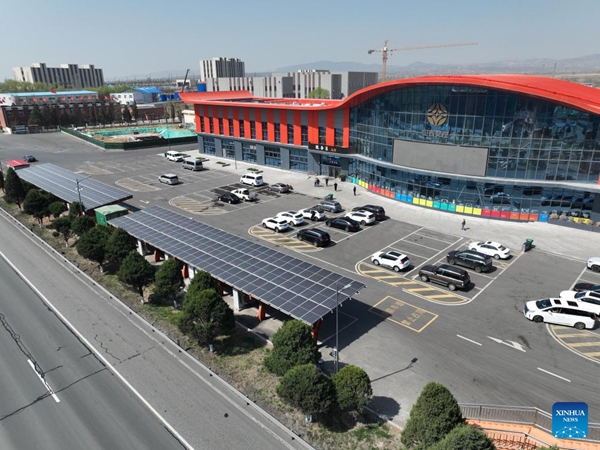China's highways in green transformation

Electric vehicle (EV) charging piles are seen in a highway service area in Taiyuan, north China's Shanxi Province, July 12, 2024. (Xinhua)
TAIYUAN, Aug. 12 (Xinhua) -- As increasing numbers of clean energy facilities are put into use, China's expressways are undergoing a green transformation.
Along the highway linking Taiyuan and Xinzhou in north China's Shanxi Province, a reflective ocean of photovoltaic (PV) panels lines slopes and rooftops, and electric vehicle (EV) charging piles are appearing with increasing frequency in service areas and at toll stations.
"Ten years ago, EV charging piles in highway service areas were rare, but now they're almost standard," said Liu Xia, who was charging her EV at the highway.
She said that EVs are convenient for highway journeys as charging infrastructure and services are expanding. "We no longer need to worry about long queues to charge during holidays and weekends."
The highway's PV system became fully operational last November, and was accredited as a national-level smart PV demonstration project by the Ministry of Industry and Information Technology this year.
"The project effectively harnesses idle land and structures through distributed solar energy generation, ensuring a stable electricity supply while mitigating carbon emissions," said Chen Jianwen, the project manager, noting that it also provides a reference for clean energy utilization on highways.
China is a leading country in the global renewable energy sector, and it is the nation with the longest expressway mileage in the world. By the end of June, there were 24.72 million new energy vehicles (NEVs) on roads in China. And there is huge development potential in the integration of highways and the PV sector.
China encourages the exploration and establishment of near-zero-carbon highway service areas, as well as the construction of related PV infrastructure, according to a set of guidelines released by the Ministry of Transport earlier this year.
Provincial-level regions across China, including Shanghai, Sichuan and Hunan, have unveiled plans to promote PV application in highway areas, focusing on the scale and distribution of PV facilities, and on energy storage technologies to bolster power system stability and power supply regulation capabilities.
Also on the national agenda is the development of facilities and services related to other forms of clean energy, such as hydrogen fuel. Since earlier this year, drivers using hydrogen-powered vehicles have benefited from toll-free highway transit within Shandong Province. Sichuan Province has formulated a similar exposure draft and plans to accelerate its construction of hydrogen refueling infrastructure in areas with abundant application scenarios.
Methanol refueling stations have been established on a new highway linking areas of Jinzhong City in Shanxi, with the road set to open to traffic by the end of this year. Methanol fuel has the advantages of efficient combustion and clean emissions, and its low freezing point means drivers need not worry about solidification issues.
Li Jianbing, who has replaced his old diesel-powered truck with a methanol-fueled vehicle, said, "It was difficult to start the diesel engine as Shanxi's winters are freezing cold. With more methanol refueling stations, travel will be more convenient."
"With continuous infrastructure upgrades along expressways, the clean energy transportation system comprising electric, hydrogen-powered and methanol-powered vehicles will be improved further," said Da Juxia, a senior engineer at Shanxi Transportation Holdings Group. "This will contribute to China's dual carbon commitments."
China has vowed to tackle climate change and follow a steadfast path of green and low-carbon development. It has pledged to peak carbon dioxide emissions before 2030 and achieve carbon neutrality before 2060.